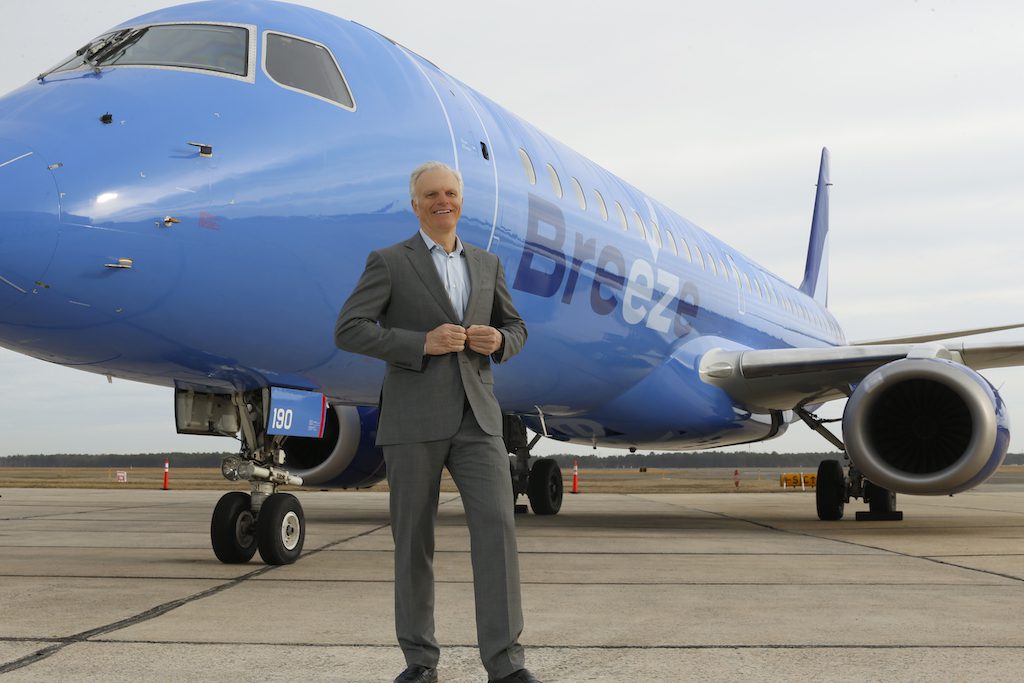Skift Take
There are probably enough qualified pilots in the United States for Breeze to hire. But some may want higher wages than Breeze wishes to pay. Why shouldn't the airline look abroad for labor? It is a perfectly legal program.
Breeze Airways, JetBlue Airways’ founder David Neeleman’s newest creation, is having so much trouble hiring pilots that it is recruiting in Australia through a unique visa program that allows pilots to receive work authorization to join U.S airlines. It’s an approach that has caught the ire of the largest pilot union in the United States, which accuses the company of trying to “undercut pilot wages.”
The E3 visa program is not new, and it is open to Australians who possess “highly specialized knowledge” in many industries. U.S. airlines have used it before, but it has generally been implemented by smaller regional carriers, such as CommutAir, a United Express airline, that often have considerable turnover as pilots move up in the ranks. Breeze, however, flies larger airplanes and competes with major U.S. airlines, mainly in the Eastern United States. The airline began flying last year with used Embraer E190s and E195s, similar to JetBlue’s. Soon, it will add new Airbus A220s, joining JetBlue and Delta Air Lines as U.S. operators.
A spokesman for Breeze said the pilot labor supply is constrained and said it made sense to post an advertisement for Australian pilots. Eligible workers can receive a two-year visa with options to extend in perpetuity.
“Covid has proved this last few weeks that the industry as a whole needs more of everyone,” said Gareth Edmondson-Jones, a spokesman for the airline. “We just increased pilot compensation this month and have seen an increase in US pilot applications — but we can always do with more.”
The Union Position
The Air Line Pilots Association, or ALPA, which represents a significant portion of pilots in the United States but has not organized at Breeze, suggested the startup airline should be able to find enough pilots.
While there is some tightness in the pilot market, as many airlines try to hire so they can respond to a post-Covid recovery, most of the trouble is coming at the smallest airlines. Pilots generally rush to fly the largest, newest airplanes, both because they like shiny new machines, and because the jets usually pay more.
“Some U.S. regional and low-cost airlines have been pursuing special visas to fill pilot positions, avoid market pressures, and undercut pilot wages,” a representative for ALPA said in an email. “There is an adequate supply of qualified pilots in the U.S. and ALPA opposes any efforts to use the visa process to undermine pay and benefits for a profession so critical to the U.S. economy and global travel.”
Breeze pays significantly less than established airlines flying the same jets, though that’s not unusual for a low-cost start-up. According to figures shared by Edmondson-Jones, a third-year captain flying the A220 will make $174 per hour, a 41 percent increase over Breeze’s earlier proposed rate. At Delta, that same captain makes $242 per hour, according to information from Airline Pilot Central, an industry website.
Creativity In Finding Labor
In creating his new airline, Neeleman has taken aggressive approaches to finding labor.
Before it launched, Neeleman said Breeze would exclusively hire flight attendants through a program for students at Utah Valley University. Online students were to be compensated through tuition reimbursement, corporate housing, and a small salary, with a total annual compensation of $43,500, the university’s website said. Several months later, after receiving criticism from a major flight attendant union, the airline signaled it would reduce its reliance on the program.
In looking to Australia for pilots, Edmondson-Jones said, the airline is trying to use similar creative ideas. The Australian market has not recovered as fast as the United States, and pilots there are permitted to work for Breeze, making it a potentially fertile applicant pool.
“There seem to be a lot of under-utilized or under-employed pilots in Australia right now,” Edmondson-Jones said. “We need to hire a few hundred pilots this year and obviously it’s super competitive.”
Is it Such a Big Deal?
ALPA tends to be a fierce defender of U.S. pilot jobs no matter the situation. But not everyone is so concerned with Breeze’s move.
“Breeze hiring from abroad is driven by difficulties attracting — recruiting and retaining — the quantity of pilots they need,” said James Onieal is owner of Raven Career Development, a Ohio-based company that helps pilots build their careers and find prime jobs.
He noted that pilots are becoming choosier in which jobs they take. He said Breeze is the only larger airline that will base pilots in Norfolk, Virginia, giving it an advantage in that market. But in other places, he said, Breeze may be a less desirable job, no matter what the airline pays.
Onieal gave Tampa as an example, noting JetBlue, Spirit, Southwest, and Frontier are all looking for pilots based in Central Florida, just like Breeze.
“When you look at the perceived —in pilots’ eyes — increased stability and pay these more established carriers offer, it becomes a bidding war,” he said. “How is a startup like Breeze supposed to compete on pay while staying competitive on ticket prices and profit margins? They are brand new and still figuring things out.”
The Daily Newsletter
Our daily coverage of the global travel industry. Written by editors and analysts from across Skift’s brands.
Have a confidential tip for Skift? Get in touch
Tags: ALPA, breeze airways, david neeleman, pilot shortage
